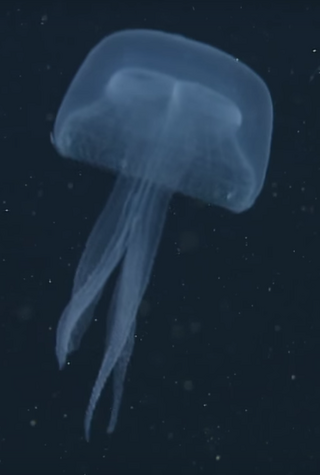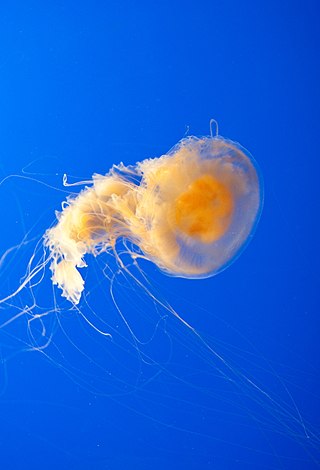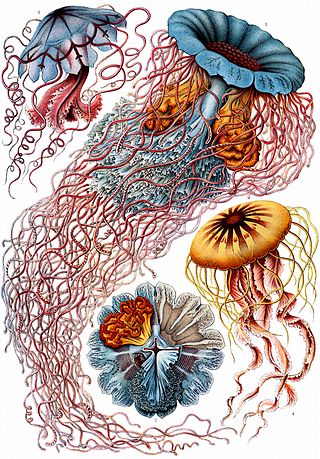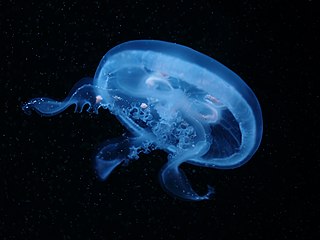
Jellyfish, also known as sea jellies, are the medusa-phase of certain gelatinous members of the subphylum Medusozoa, which is a major part of the phylum Cnidaria.

The Scyphozoa are an exclusively marine class of the phylum Cnidaria, referred to as the true jellyfish.

Aurelia aurita is a species of the family Ulmaridae. All species in the genus are very similar, and it is difficult to identify Aurelia medusae without genetic sampling; most of what follows applies equally to all species of the genus.

Stellamedusa is a genus of jellyfish. The genus is monotypic with a single species recognized, Stellamedusa ventana.

Semaeostomeae is an order of large jellyfish characterized by four long, frilly oral arms flanking their quadrate mouths. The umbrella is domed with scalloped margins, and the gastrovascular system consists of four unbranched pouches radiating outwards from the central stomach; no ring canal is present. They usually possess eight tentacles; four are per-radical and four are inter-radical.

Phacellophora camtschatica, commonly known as the fried egg jellyfish or egg-yolk jellyfish, is a very large jellyfish in the family Phacellophoridae. This species can be easily identified by the yellow coloration in the center of its body which closely resembles an egg yolk, hence how it got its common name. Some individuals can have a bell close to 60 cm (2 ft) in diameter, and most individuals have 16 clusters of up to a few dozen tentacles, each up to 6 m (20 ft) long. A smaller jellyfish, Cotylorhiza tuberculata, typically found in warmer water, particularly in the Mediterranean Sea, is also popularly called a fried egg jellyfish. Also, P. camtschatica is sometimes confused with the Lion's mane jellyfish.

Discomedusae is a subclass of jellyfish in the class Scyphozoa. It is the sister taxon of Coronamedusae. Discomedusae contains about 155 named species and there are likely to be many more as yet undescribed. Jellyfish in this subclass are much more likely to have swarming events or form blooms than those in Coronamedusae. Discomedusae consists of two orders, Rhizostomeae and Semaeostomeae.

Tiburonia is a genus of jellyfish in the family Ulmaridae. It was reported in 2003, following the discovery of its only species yet identified, Tiburonia granrojo. It was discovered by a crew from MBARI led by George Matsumoto. Pieces of the medusae were collected for morphological analysis, which eventually led to sequencing and taxonomic identification. The discovery of this organism led to not only a new species, but a new subfamily of Ulmaridae, called Tiburoniinae. Its genus was named Tiburonia after the ROV the crew were using, called Tiburon, meaning "shark" in Spanish. Because of this ROVs distinct maneuverability, all angles of the organisms were able to be observed, which is particularly important to the study of gelatinous pelagic invertebrates. Its species name was originally to be called "big ugly", but Kirsten Matsumoto, George Matsumoto's wife, raised objections to this name, and renamed it granrojo, meaning "big red" in Spanish, leading to its English-language name, the Big Red Jellyfish.

Deepstaria enigmatica is a very rarely seen giant jellyfish of the family Ulmaridae first described in 1967 by F. S. Russell.

Aurelia is a genus of jellyfish that are commonly called moon jellies, which are in the class Scyphozoa. There are currently 25 accepted species and many that are still not formally described.

Stygiomedusa gigantea, commonly known as the giant phantom jelly, is the only species in the monotypic genus of deep sea jellyfish, Stygiomedusa. It is in the Ulmaridae family. With only around 110 sightings in 110 years, it is a jellyfish that is rarely seen, but believed to be widespread throughout the world, with the exception of the Arctic Ocean.

Aurelia labiata is a species of moon jellyfish. It is a cnidarian in the family Ulmaridae. It is typically larger than Aurelia aurita, with individuals document up to 45 cm (18 in). However, much of its size range overlaps with A. aurita, making size an imperfect diagnostic tool. Most Aurelia labiata have a 16-scalloped bell, meaning the bell indents inward at 16 points, a characteristic that also appears in other Aurelia species. Aurelia labiata occurs in the northeastern Pacific Ocean, from the northern coast of California, north to Canada and into Alaska.

Aurelia limbata, the brown-banded moon jelly, is a type of moon jelly that occurs in various places throughout the Pacific Ocean.
Aurelia ayla is a species of true jellyfish in the family Ulmaridae. It is known via type specimens found in waters off the coast of Bonaire.
Aurelia cebimarensis is a species of true jellyfish in the family Ulmaridae. It is known via type specimens found in waters off the coast of Brazil.
Aurelia hyalina is a species of true jellyfish belonging to the family Ulmaridae. It was formerly considered conspecific with Aurelia limbata.
Aurelia malayensis is a species of true jellyfish in the family Ulmaridae. It is known via type specimens found in the Philippines.
Aurelia mianzani is a species of true jellyfish in the family Ulmaridae. It is found in waters off the coasts of Brazil and Argentina.
Aurelia miyakei is a species of true jellyfish in the family Ulmaridae. It is found in the Gulf of Thailand and the Kwajalein Atoll.
Aurelia rara is a species of true jellyfish in the family Ulmaridae. It is known from type specimens found near Dauphin Island.













